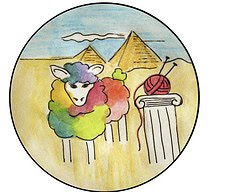I don’t usually post twice on the same day (heck, sometimes I don’t even post twice in the same month!) but I couldn’t wait to share my solution to obtaining a jogless jog in an alternating multiple-row/single-row striped pattern when knitting in the round.
I’ve been knitting a pair of striped pedicure socks called “Peekaboo” from The Joy of Sox and have been frustrated at my inability to disguise or minimize the jog that occurs when changing colours. Even though the colour changes are located on the sole of the socks and will therefore be hidden when the socks are worn, I have been dissatisfied with what I consider a defect in my knitting.
The sock features a two-colour sequence, five rows of Colour A followed by one row of Colour B. As I knit the first sock I experimented with several methods of changing colours, even resorting to joining in and ending a separate strand of yarn for each single-row stripe of Colour B. Not only did this fail to solve the problem, it also made for a lot of ends to weave in. I searched knitting books and the internet for a solution but although I found various methods for single-row stripes or multiple-row stripes, nothing seemed to address the issue of a multi-row/single-row sequence.
As I knit the second sock my thoughts kept returning to the slipped-stitch method demonstrated in this video but I didn’t think it would work because it requires you to knit one round of the new colour before slipping the first stitch on the second round and Stripe B is only one round high. However, with a little experimentation I came up with a modification to this method and finally achieved a jogless jog.
Here’s how it’s done:
1. After knitting the desired number of rows for Stripe A, begin Stripe B by slipping the first stitch of the next round, then knit to the end of the round with Colour B.


3. Knit desired number of rows with Colour A.
4. Repeat Steps 1-3 with each colour change.
Voila! Practically jogless jogs.

Now that I’ve mastered the jogless jog I’m tempted to frog the first sock and reknit it but considering that a) it’s a pedicure sock and nobody will ever see it but me, b) they’re made from leftovers, for heaven’s sake, and c) I’m ready to move onto another project, I think I’ll just finish up the second sock and keep the first as it is to remind me of a knitting lesson learned.





No comments:
Post a Comment